BitTorrent and uTorrent are both proprietary (closed-source software) BitTorrent clients supported by ads (adware). Both belong to the same company, Rainberry, Inc. (former BitTorrent, Inc.), responsible for the continuous development of the one and only BitTorrent P2P protocol and the two torrent clients, uTorrent and BitTorrent, along with many other products.
The difference between BitTorrent vs. uTorrent is in their supportability. The classic version of both clients is not supported by the same platforms. uTorrent Classic is supported by Windows, Linux, and macOS, while BitTorrent Classic is only supported by Windows.

Disclaimer: This material has been developed strictly for informational purposes. It does not constitute endorsement of any activities (including illegal activities), products or services. You are solely responsible for complying with the applicable laws, including intellectual property laws, when using our services or relying on any information herein. We do not accept any liability for damage arising from the use of our services or information contained herein in any manner whatsoever, except where explicitly required by law.
Table of Contents.
1. BitTorrent vs. uTorrent: Differences in History.
2. BitTorrent vs. uTorrent: Products and UI
3. BitTorrent vs. uTorrent: Capabilities and Features.
1. BitTorrent vs. uTorrent: Differences in History.
We can describe BitTorrent vs. uTorrent differences using history—How the two “historically” quite distinct and competitive torrent downloaders evolved into twin brothers.
Side note: Do not confuse BitTorrent Inc, BitTorrent, and BitTorrent Client. One is the company, another is the protocol, and the last is the torrent downloader software.
A. BitTorrent:
In 2001, Bram Cohen created the popular BitTorrent protocol and its first client with the same name. BitTorrent (torrent downloader) was the first torrent client developed purposefully for the BitTorrent protocol. The BitTorrent client is also referred to as the BitTorrent Mainline. The last version of the original BitTorrent was BitTorrent 5.30 (free and open-source).
Below is a snapshot (thanks to Wayback Machine) of the BitTorrent homepage during the 4.2.0 release (prior to 6.0).
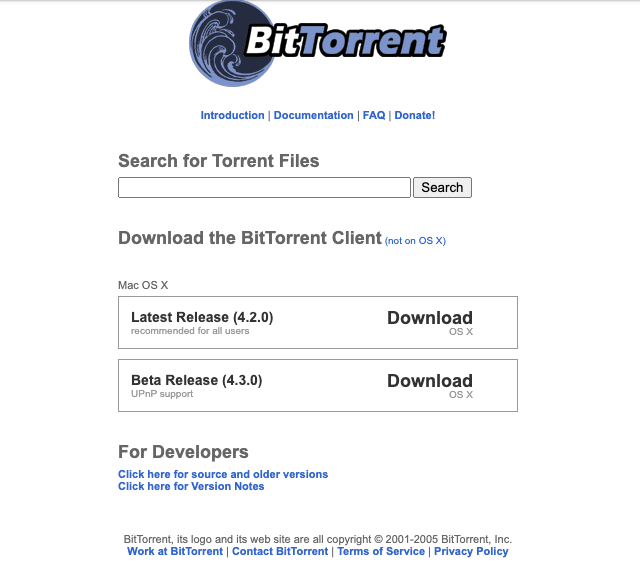
During the BitTorrent version 6.0 release, there were a couple of dramatic changes. First, the software became proprietary and ad-supported, and second, the BitTorrent developers took the code from uTorrent and created a rebranded BitTorrent version of uTorrent. As of 2018, the Rainberry company was acquired by TRON, a decentralized and open-source blockchain-based OS. They took the BitTorrent client and created the newest version, BitTorrent Speed.
B. uTorrent:
uTorrent was publicly released in 2005 (version 1.1 beta) as a much lighter (bloatware-free) alternative to the BitTorrent Mainline client— thus, the odd “μ” in μTorrent, which is the Greek letter “mu,” for micro. μTorrent (or easier, uTorrent) quickly gained traction as a lighter alternative to larger clients such as BitTorrent, Vuze, and BitComet. uTorrent consumed minimal computer resources, and so the millions of torrent users took a keen interest in uTorrent.
Below is a snapshot (thanks to Wayback Machine) of the uTorrent homepage during the 1.3 release in 2005.
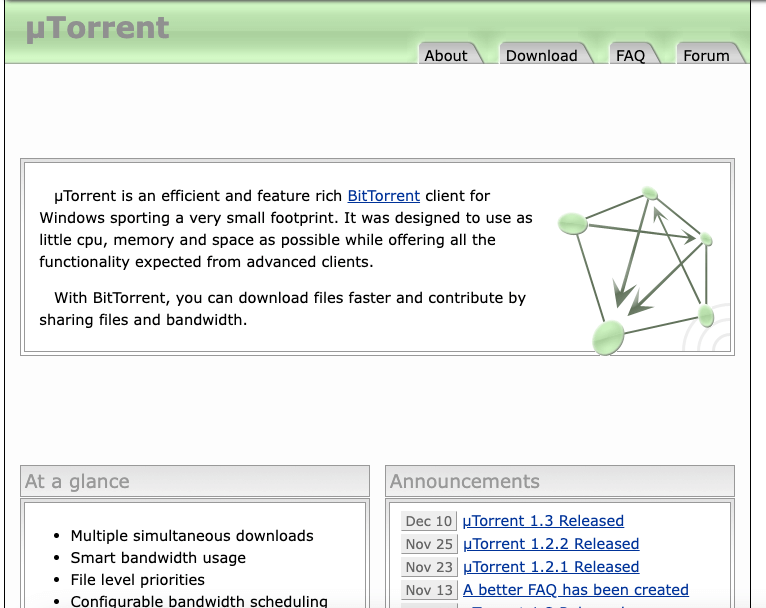
During the following year, 2006, uTorrent was acquired by the BitTorrent Inc company. From 2006 to 2014, uTorrent was one of the favorite and most globally used BitTorrent clients until 2015. Although they were already adding bloatware and crapware before 2015, the company decided to add a hidden crypto-miner in the default installation. Now, all uTorrent clients were installing and using uTorrent with a crypto miner running in the background without a user’s knowledge. After this incident, uTorrent long-time users lost all credibility in their software and moved to other torrent clients. Although this unintelligent move smashed their reputation, uTorrent is coming clean again as fast and light as before.
Verdict:
uTorrent was ideal and the favorite for millions for many years, but including a hidden crapware broke their reputation. As of today, 2022, many long-time users advise new users against uTorrent (probably for good historical reasons). BitTorrent on the other hand, (which took the code from uTorrent) focused more on commercializing its product. They were the first ones to provide a pro version of their software.
Torn between BitTorrent and uTorrent?
Streamline your torrenting experience with RapidSeedbox’s high-speed seedboxes. Whether you choose BitTorrent or uTorrent, our services ensure fast downloads, reliable performance, and exceptional support.
2. BitTorrent vs. uTorrent: Products and UI
A. BitTorrent:
The BitTorrent client offers torrent downloader products ranging from the popular BitTorrent Classic (only Windows), BitTorrent Web (Mac and Windows), and BitTorrent Android. In addition, they also offer BitTorrent Remote, a “content utility” to manage your torrents remotely and access your home-based (or seedbox-based) BitTorrent client. Also, you will likely notice that the BitTorrent Inc. company (after being bought by TRON) is now moving towards Crypto-based products. They now offer a version of the BitTorrent client that can help you earn BTT tokens (BitTorrent Speed) and the decentralized BitTorrent File System (BTFS).
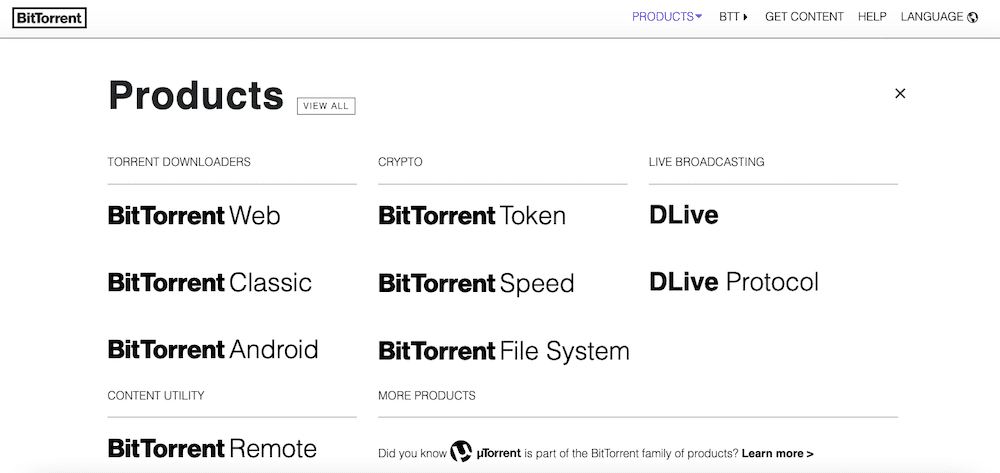
BitTorrent Classic offers the following plans:
- The Basic. An original free BitTorrent app supported by ads).
- The Ad-free. The classic BitTorrent app, without ads, is optimized to use less bandwidth, and with premium support. The price: $4.95/year
- The Pro: The Ad-free BitTorrent app + a Malware detection/protection system (Safe torrent scanner), a media player, and premium support. The price: $19.95/year
- The Pro + VPN: The Pro BitTorrent app + one-year subscription of CyberGhost VPN (for up to 5 devices). The price: $69.95/year.
B. uTorrent:
uTorrent provides their uTorrent Classic which is supported by Windows, Mac, and Linux (Debian 6.0, Debian 7.0, Ubuntu 12.4, and Ubuntu13.04). uTorrent also provides their version of uTorrent Web (supported by Windows and Mac) and the now favorite uTorrent Remote, which allows you to access your home-based (or seedbox-based) uTorrent client and manage your torrents anyhow you want.
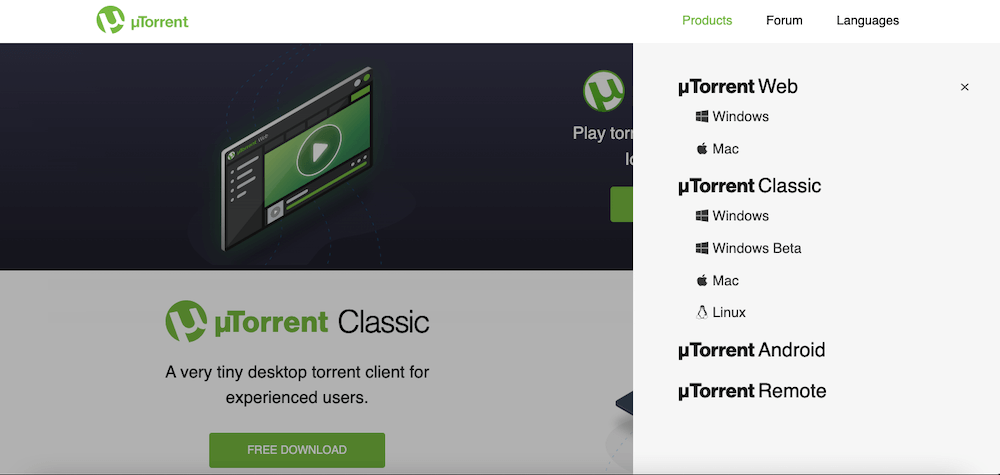
Again, being from the same company, uTorrent offers the exact same basic and pro plans as BitTorrent Classic clients: Basic, Ad-free, Pro, and Pro+VPN (all with the same prices).
Verdict:
There are simply not many differences in BitTorrent vs. uTorrent UI’s. Their Graphical User Interfaces are practically the same. If you know how to use one, you’ll be instantly capable of using the other. In fact, if you put their classic version or the web-based version, they look exactly alike.
The uTorrent vs BitTorrent web-based version (next to each other).

Both BitTorrent Classic clients (for Windows) allow you to connect with a Remote (content utility) from anywhere and on any device (including iOS) and manage your torrents. In addition, both Web-based versions of their software are supported by Windows and macOS.
Still, there are some differences in their Classic torrent downloader version. BitTorrent Classic is only supported by Windows, while uTorrent Classic is supported by Linux and macOS. Another noticeable difference is that BitTorrent Speed (a new BitTorrent client) comes with a built-in wallet and can let you earn BTT (which is not yet fully embraced by the community).
3. BitTorrent vs. uTorrent: Capabilities and Features.
A. BitTorrent.
BitTorrent Classic comes with all the necessary (and advanced) capabilities for your torrenting needs. You can download multiple torrent files simultaneously, assign different priorities to each download, and schedule automatic downloads. The BitTorrent torrenting client comes with all essential features, including support for μTP, IPv6, DHT, PEX, LDP, super-seeding, HTTP seeding, RSS feeds, magnet URI, embedded tracker, HTTP tracker, BitTorrent encryption, UPnP, NAT-PMP, and proxy server support (SOCKS5).
BitTorrent Speed is accessible via BitTorrent Web. And it is a built-in app with a crypto wallet and BTT tokens that can be earned by sharing and that can also help you increase torrenting speed. Speed can also be accessed via the uTorrent Web-based client.
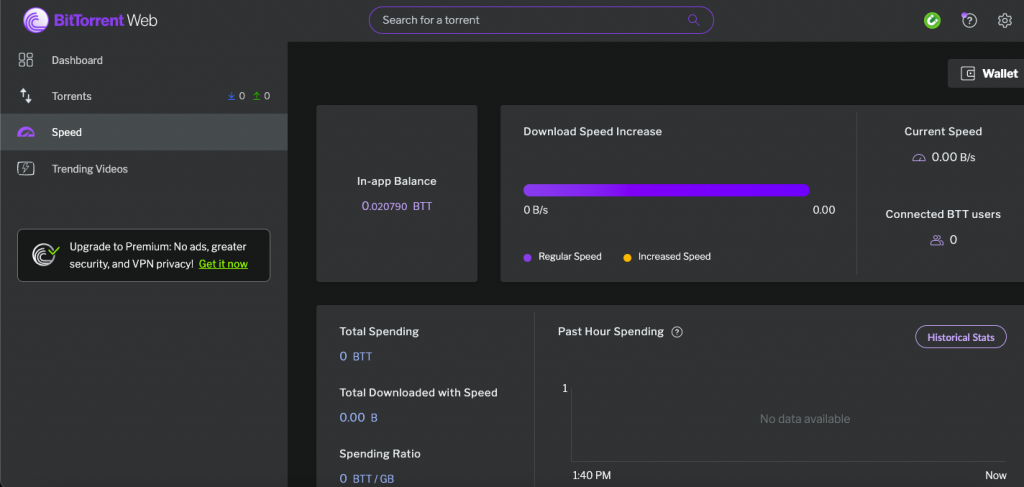
B. uTorrent
Just like the BitTorrent client, uTorrent also comes with basic torrenting functionalities, including support for URI magnet links, IPv6, µTP, UPnP, PE, PEX, RSS feeds, DHT, proxy server support (SOCKS5), HTTP tracker, bandwidth scheduler, embedded tracker, and more. In addition, you can also limit the number of connections, limit the rate, enable transfer caps, queuing, and more.
Although uTorrent Basic (and BitTorrent Basic) come with ads, there are some workarounds to turn uTorrent ads on or off. You can also optimize bandwidth if you know how to tweak the uTorrent settings. Plus, both uTorrent and BitTorrent web browser-based versions allow you to stream torrents right from the web browser’s media player.
Verdict.
One of the most significant differences between uTorrent vs. BitTorrent was in their program size: the previous uTorrent (stable version 2.2.1 for Windows was only 390.37 KB. Now, the latest stable uTorrent (3.5.5) has grown to about 2.2MBs, which is still considered small. Still, BitTorrent (the latest and stable) executable file is also around 2.4MB, which is not a big difference. In addition, both torrent downloaders have fantastic support for all modern torrenting technology when it comes to the capabilities.
One of the significant differences between BitTorrent vs. uTorrent that you will quickly notice is that the BitTorrent ecosystem is leaning towards Blockchain technology and decentralization. So you will soon see lots of differences between uTorrent and BitTorrent Speed (especially that Speed comes with a wallet and lets you earn BTT tokens).
Torn between BitTorrent and uTorrent?
Streamline your torrenting experience with RapidSeedbox’s high-speed seedboxes. Whether you choose BitTorrent or uTorrent, our services ensure fast downloads, reliable performance, and exceptional support.
Final Verdict
BitTorrent and uTorrent are twin brothers born out of different mothers. Since uTorrent and BitTorrent use the same code, UI, and even have the exact pricing, they are almost identical. Both have the same results for BitTorrent vs. uTorrent for speed, performance, security, feature-set, and resource utilization.
Some torrent users would even argue that the only difference nowadays between BitTorrent and uTorrent is in their logo. However, their different backgrounds can help withdraw some distinctions.
Although Web-based and Remote clients are the same, uTorrent and BitTorrent Classic versions do have differences: their supportability. BitTorrent Classic is supported only by Windows, while uTorrent Classic is supported by Windows, macOS, and Linux.
Thanks for the info. I enjoy receiving these articles. Is BitTorrent available for use in my rapid seedbox? How would it compare to rutorrent and deluge?
Gerry, you are welcome! We are glad that you enjoy these articles. Unfortunately, the BitTorrent client is not available by default on your seedbox. We focus on other torrent clients such as Deluge, qBitTorrent, rTorrent, and ruTorrent. You could install it in your fully managed seedbox server.
Comparing it with ruTorrent and Deluge? They are totally different beasts! thanks for the content idea! We will likely come up with a full comparison post.
These popular torrent clients come as one-click apps. I personally love Deluge…. lots of seedbox experts wouldn’t live without ruTorrent, and the majority of people like BitTorrent. It would be a matter of tesing different clients and putting everyhing into the balance.